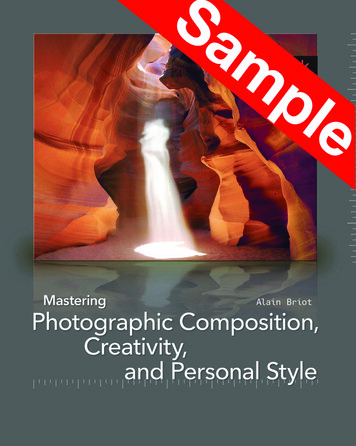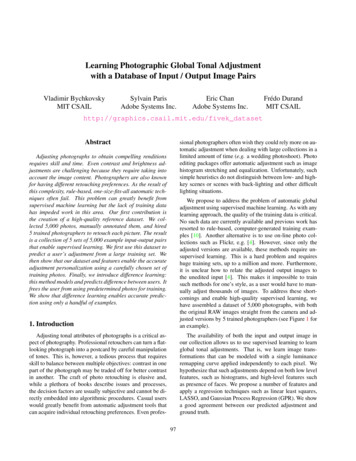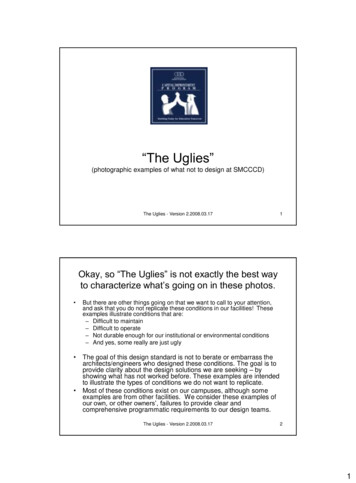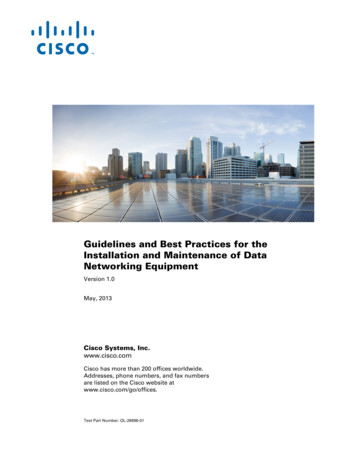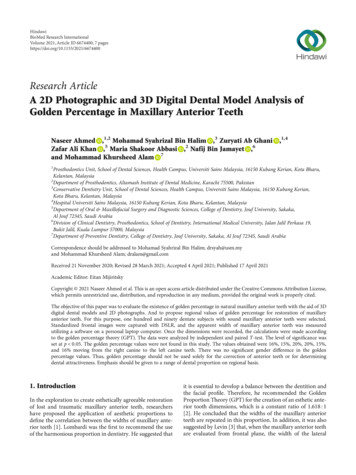
Transcription
HindawiBioMed Research InternationalVolume 2021, Article ID 6674400, 7 pageshttps://doi.org/10.1155/2021/6674400Research ArticleA 2D Photographic and 3D Digital Dental Model Analysis ofGolden Percentage in Maxillary Anterior TeethNaseer Ahmed ,1,2 Mohamad Syahrizal Bin Halim ,3 Zuryati Ab Ghani ,1,4Zafar Ali Khan ,5 Maria Shakoor Abbasi ,2 Nafij Bin Jamayet ,6and Mohammad Khursheed Alam 71Prosthodontics Unit, School of Dental Sciences, Health Campus, Universiti Sains Malaysia, 16150 Kubang Kerian, Kota Bharu,Kelantan, Malaysia2Department of Prosthodontics, Altamash Institute of Dental Medicine, Karachi 75500, Pakistan3Conservative Dentistry Unit, School of Dental Sciences, Health Campus, Universiti Sains Malaysia, 16150 Kubang Kerian,Kota Bharu, Kelantan, Malaysia4Hospital Universiti Sains Malaysia, 16150 Kubang Kerian, Kota Bharu, Kelantan, Malaysia5Department of Oral & Maxillofacial Surgery and Diagnostic Sciences, College of Dentistry, Jouf University, Sakaka,Al Jouf 72345, Saudi Arabia6Division of Clinical Dentistry, Prosthodontics, School of Dentistry, International Medical University, Jalan Jalil Perkasa 19,Bukit Jalil, Kuala Lumpur 57000, Malaysia7Department of Preventive Dentistry, College of Dentistry, Jouf University, Sakaka, Al Jouf 72345, Saudi ArabiaCorrespondence should be addressed to Mohamad Syahrizal Bin Halim; drsyah@usm.myand Mohammad Khursheed Alam; dralam@gmail.comReceived 21 November 2020; Revised 28 March 2021; Accepted 4 April 2021; Published 17 April 2021Academic Editor: Eitan MijiritskyCopyright 2021 Naseer Ahmed et al. This is an open access article distributed under the Creative Commons Attribution License,which permits unrestricted use, distribution, and reproduction in any medium, provided the original work is properly cited.The objective of this paper was to evaluate the existence of golden percentage in natural maxillary anterior teeth with the aid of 3Ddigital dental models and 2D photographs. And to propose regional values of golden percentage for restoration of maxillaryanterior teeth. For this purpose, one hundred and ninety dentate subjects with sound maxillary anterior teeth were selected.Standardized frontal images were captured with DSLR, and the apparent width of maxillary anterior teeth was measuredutilizing a software on a personal laptop computer. Once the dimensions were recorded, the calculations were made accordingto the golden percentage theory (GPT). The data were analyzed by independent and paired T-test. The level of significance wasset at p 0:05. The golden percentage values were not found in this study. The values obtained were 16%, 15%, 20%, 20%, 15%,and 16% moving from the right canine to the left canine teeth. There was no significant gender difference in the goldenpercentage values. Thus, golden percentage should not be used solely for the correction of anterior teeth or for determiningdental attractiveness. Emphasis should be given to a range of dental proportion on regional basis.1. IntroductionIn the exploration to create esthetically agreeable restorationof lost and traumatic maxillary anterior teeth, researchershave proposed the application of aesthetic proportions todefine the correlation between the widths of maxillary anterior teeth [1]. Lombardi was the first to recommend the useof the harmonious proportion in dentistry. He suggested thatit is essential to develop a balance between the dentition andthe facial profile. Therefore, he recommended the GoldenProportion Theory (GPT) for the creation of an esthetic anterior tooth dimensions, which is a constant ratio of 1.618 : 1[2]. He concluded that the widths of the maxillary anteriorteeth are repeated in this proportion. In addition, it was alsosuggested by Levin [3] that, when the maxillary anterior teethare evaluated from frontal plane, the width of the lateral
2incisor should be in golden proportion to the width of centralincisor and width of canine to the lateral incisor. A grid withcolumns in golden proportion was invented by him and lateron proposed, to use the grid for evaluation and developmentof harmonious maxillary anterior teeth restorations [3].However, the recent literature reported that variations havebeen observed in dental features; hence, in aesthetically pleasing smiles, the golden ratio was not found [4–7].As an alternate, other principles were introduced for theimplementation of esthetic restoration in the labial segmentincluding RED (recurring esthetic dental proportion), (Preston Proportion) and GP (golden percentage). The RED wasrecommended by Ward [8, 9]. He described it as “the proportion of the successive width of the teeth remaining constantwhen progressing distally from the midline.” Moreover, Preston studied the occurrence of golden proportion and foundthat it only existed in 17% of the subjects [10]. Therefore,he suggested Preston’s proportion, which states that “thewidth of maxillary lateral incisor should be 66% the widthof central incisors and the width of maxillary canines shouldbe 55% the width of maxillary central incisors when observedfrom the frontal view.” Consequently, Snow proposed a bilateral ratio for each anterior tooth in percentage of the totalapparent intercanine width. He named it golden percentagetheory (GPT), as it was a modification of the golden proportion concept. GPT states that the width of maxillary centralincisor should be 25%, lateral incisors 15%, and caninesshould be 10%, respectively, of the intercanine distance, asmeasured from the distal surface of one canine to the other[11]. This concept has been investigated by researchers andsuggested ethnic variations in percentage around the globe[12–14]. This study evaluated the existence of golden percentage in a selected sample of Pakistani population. Thepurpose of this study was to evaluate the presence of GPTbetween natural maxillary anterior teeth in local adult population. The evidence from the current study could be used asreference for the restoration of the esthetically demandinganterior segment and may be used to reestablish the dimensions of teeth during periodontal surgery, restorative dentistry, and prosthetic rehabilitation clinically.2. Materials and Methods2.1. Study Setting and Sample Size. This study was carried outat Altamash Institute of Dental Medicine Karachi (AIDM),Pakistan. The sample size was calculated with public serviceof creative research systems survey software (creativeresearch systems, version 9, Petaluma, California, UnitedStates). Considering 62% [13] prevalence of dental proportion and estimated sample size at 5% margin of error with95% confidence interval, 227 individuals with intact naturalmaxillary anterior teeth were invited to participate in thisstudy, considering the 10,000,000 population.2.2. Ethical Consideration and Participant Recruitment. Theethical and review board of AIDM (AIDM/EC/06/2019/06)and Universiti Sains Malaysia (USM/JEPeM/19060380)approved this study. The objective, consent statement forvoluntary participations and declarations of anonymity andBioMed Research Internationalconfidentiality were clarified and sought out for all participants before participation in this study. Students, employees,coworkers, and other staff studying/working at the campuswere interviewed first and examined clinically; those whofitted our inclusion and exclusion criteria were selected. 37participants were excluded based on selection criteria, and atotal of 190 subjects were included in the study. The ageand nationality of participants was noted and confirmed bynational identity card. The basic information, form number,age, gender, and contact details were recorded.The inclusion criteria were individuals with intact dentition, caries and periodontal disease-free anterior teeth, lackof faciodental asymmetry, and no restorative treatment donein anterior teeth, i.e., veneers, crown, and bridge work.Patient’s age ranges from 18 to 30 years on the date ofexamination.2.3. 2D Photograph and 3D Digital Model Making. A digitalcamera (Canon EOS, DSLR Camera, CMOS, 18 MP,1920 X1080p/30fps) body was used in this study. The camera wasequipped with a built-in magnification lens of 18 55 mm 75 300 mm to capture crisp clear and reproducibleimages. The 1 : 1 macrosetting was used for close-up imagingof teeth and generally included the four maxillary incisorsand canine on the sensor. The camera was mounted on a tripod, set at 12 o’clock position with a standardized focus andplace at a distance of 1.5 meters from the subjects to ensuredistortion free images. The surrounding lighting remainedthe same for all the photographs. Ring flashlight source system (LED-FD,480II, Medike Photo and Video Co., Ltd. Yidoblo, Guangdong, China) was used, and its configurationconsisted of a flash unit that were mounted next to the lens.The height of the lens of camera was adjusted on the tripodto match the incisors level for retracted smile image capture.Subjects were seated upright with shoulders and head heldstraight and facing forward, towards the lens of the camera.Head position was standardized along both horizontal andvertical axes. Then, the upper lip was retracted in all intraoralphotographs to clearly display the maxillary anterior teeth.This procedure was similar to the protocol described by Bidraet al. [15] as presented in Figure S3.For 3D measurement of maxillary arch, impressions weremade of all subjects with irreversible hydrocolloid impressionmaterial on their maxillary arch (fast setting alginate hydrogum; Zharmack Spa) and were poured with type IV dentalstone (ISO Type 3, Elite Rock Zharmack Spa). The casts werecoded with serial number of the subjects using permanentmarker. In order to obtain a 3D model, the cast was scannedby UP3D Dental Laboratory Scanner (UP360 , 300 300 400 mm, 3D scanner, Shenzhen, China). The scanner wasequipped with 2.0 MP cameras that can scan with high precision upto 6 μm. The full arch 3D scan was obtained in 20 seconds. The scan image was displayed on a compatible dentaldesign software (UPCAD, UP3D, Shenzhen, China), thentransferred via USB to store in a personal computer asdescribed in Figure S2.2.4. Validity and Reliability Control. In our study, all datafrom 2D photographs and 3D dental models were collected
BioMed Research CIWICWLLIWICW10%canine teeth, it was considered that the teeth are in goldenpercentage (Figure 1).LCWICWICW100%Figure 1: The methodological assessment of golden percentagebetween the widths of maxillary anterior teeth in this study.RCIW: right central incisor width; RLIW: right lateral incisorwidth; RCW: right canine width; ICW: intercanine width; LCIW:left central incisor width; LLIW: left lateral incisor width; LCW:left canine width.by a single operator. To overcome interoperator biasness,20% of the photographs and models were initially measuredby a senior working colleague. The readings obtained werecompared with calculations carried out by the principalinvestigator. The correlation obtained between the operatorsreading was 0.79 in current study. Furthermore, to minimizeintraoperator biasness, firstly, each measurement was performed three times, and the mean value was calculated. Secondly, 20% of models and photographs were remeasured bythe same operator after a period of two weeks. A strong correlation of 0.89 was found after analysis through Dahlberg’sformula ME ðΣ ðx1 x2Þ2/2ð28ÞÞ1/2.For validity purpose, 20% of data from direct tooth measurement via a sharp tip digital vernier caliper was comparedwith actual tooth widths obtained through digital dentalmodels and assessed through intraclass correlation coefficient test (ICC). A strong correlation value of 0.81 wasfound.To avoid magnification error by figuring a conversionfactor which was derived by dividing dimensions of cast teethby the image dimension [7], the width of each tooth was multiplied by the factor in order to find out the true width captured in the photographs.2.5. Teeth Measurement. The actual width of the anteriorteeth was recorded with 3D scanner software on the models.Mesiodistal widths (actual width) of central incisors, lateralincisors, and canines were measured from the facial sideusing measuring tool device positioned between the contactpoints of each tooth from contact to contact point of teethas presented in Figure S1(a).Then, the obtained images were processed in Photoshop2020 (Adobe, version 21.0.2, San Jose, California, UnitedStates). The width of teeth between contact points in centralincisors and visible width of lateral incisor and canine teethon each side of the arch were measured from labial aspectas shown in Figure S1(b). The data collected was recordedin separate computer sheets for future analysis.2.6. Golden Percentage Calculation. For estimation of goldenpercentage of maxillary anterior teeth widths, the mesiodistaldistance of central, lateral incisors and canine teeth fromeach side of the arch was divided by the intercanine widthand further multiply by 100 to obtain percentage values. Ifthe values obtained were 25%,15%, and 10% from right to left2.7. Statistical Analysis. The data was analyzed with StatisticalPackage for the Social Sciences Software (IBM, SPSS statistics, version 25, Chicago, Illinois, United States). Descriptiveanalysis of qualitative and quantitative variable, i.e., age, gender and golden percentage, was carried out to calculate theirmean, standard deviation, and percentage values. Furthermore, mean values of dependent (anterior teeth width,golden percentage) and independent (age, gender) variableswere compared using independent and paired T-test. Thedistribution of data was analyzed with normality plots andtesting (Shapiro-Wilk and Kolmogorov-Smirnov). A p value 0.05 was taken as statistically significant.3. ResultsThis descriptive analytical study consisted of 190 participants. The response rate was 83.70% and dropout rate16.29%, respectively. In our study, 79 (41.6%) participantswere male and 111 (58.4%) females with a mean age of 21:9 2:62 years. Normal distribution curve was observed in dataof most independent variables, i.e., maxillary anterior teethwidth and dental proportion values.The mean width for upper right central incisor (URCI)was 7:99 0:61, 6:07 0:82 for upper right lateral incisor(URCI) and 6:68 1:11 for upper right canine (URC), while7:87 0:79 for upper left central incisor (ULCI), 6:01 0:83upper left lateral incisor (ULCI), and 6:42 1:18 for upperleft canine (ULC) teeth, respectively. The intercanine widthwas 41:07 3:85 amongst the participants. There was a significant difference between mean width of right and left central incisors, canine teeth (p 0:001) and (p 0:001) whileno significant difference (p 0:293) was seen between themean width of lateral incisor teeth on both sides of the archas described in Table 1.Furthermore, the mean golden percentage values foranterior teeth were 19.44% for upper right central incisor(URCI), 14.79% for upper right lateral incisor (URLI),16.22% for upper right canine (URC), 19.23% for upper leftcentral incisor (ULCI), 14.65% for upper left lateral incisor(ULCI), and 15.57% for upper left canine (ULC), respectively, as depicted in Table 2. There was a significant difference (p 0:05) between the values obtained in this studyand the one proposed by Snow 25%, 15%, and 10% as mentioned in Figure 2.The mean dental proportion width in respect to genderobtained in our study is presented in Table 3. The meanvalues were (starting from the right canine side to left uppercanine teeth) 16.22%, 14.79%, 19.44%, 19.23%, 14.65%, and15.57%. Moreover, there was no significant difference betweendental proportion of teeth amongst male and females(p 0:05) in all anterior teeth except right lateral incisor(p 0:011) and (p 0:014). The relationship between valuesof dental proportions obtained in this study and golden percentage theory suggested by Snow [11] is described inFigure 2. Additionally, there was a significant difference
4BioMed Research InternationalTable 1: Characteristics of maxillary anterior teeth widths (n 190).VariablesRangeMinimumMaximumMeanStd. IWLCWRCWp value0.0010.2930.001RCIW: right central incisor width; RLIW: right lateral incisor width; RCW: right canine width; ICW: intercanine width; LCIW: left central incisor width; LLIW:left lateral incisor width; LCW: left canine width.Table 2: Distribution of golden percentage in maxillary anteriorteeth (n aximumMeanStd. 314.6515.570.020.010.020.010.010.02GpRCI: golden percentage right central incisor; GpRLI: golden percentageleft lateral incisor; GpRC: golden percentage right canine; GpLCI: goldenpercentage left central incisor; GpLLI: golden percentage left lateral incisor,golden percentage left canine.25%25%19.44%19.23%15% 14.79%15% 14.65%Lateral incisor leftCentral incisor leftCentral incisor right10%Lateral incisor rightCanine right10%15.57%Canine left16.22%Suggested golden percentageAcquired golden percentageFigure 2: The difference between the golden percentage suggestedby Snow and dental proportion obtained in this study (n 190).(p 0:026) between the mean teeth widths obtained from 3Dmodels and 2D photographs in this study.However, no statistically significant difference was foundbetween the width of the right (p 0:505) and left (p 0:741)central incisors, similarly between right (p 0:780) and leftcanines (p 0:645) in females. Although a statistically significant difference was seen (p 0:030) between right lateralincisor widths in females. Additionally, there was no statisti-cally significant difference between the widths of the right(p 0:510) and left central incisors (p 0:742), also in right(p 0:776) and left canines (p 0:647) amongst male participants. Whereas a statistically significant difference wasfound amongst the widths of right lateral incisors(p 0:031). Lastly, there was no significant differencebetween the mean intercanine width in male (p 0:602)and female (p 0:605) as mentioned in Table 4.4. DiscussionThe formation of a geometric relationship in anterior teeth ofmaxilla is essential in order to make an esthetically acceptablerestoration. It would be convenient and beneficial if statistically reliable relationships are created, to support teeth proportion theories [16]. In this regard, most analysis is carriedout on photographs and dental casts widely; however,attempts have been made by several researchers to minimizethe photographic magnification error [7, 16, 17]. In thisstudy, W.H Ward concept was used to avoid magnificationerror by figuring a conversion factor, which was derived bydividing dimensions of cast teeth by the image dimension [7].The dental proportion values in our study were in contrast with standard golden percentage [11] as we found avalue of 16.22%, 14.79%, 19.44%, 19.23%, 14.65%, and15.57%, from the right canine to left canine teeth. Murthyand Ramani found a dimension of 12.5%, 15.5%, 22%, 22%,15.5%, and 12.5% in front teeth [14] on standardized teethimages from 56 dental students of Asian origin. Maharjanand Joshi in their research on Mongoloid/Aryan populationfound a golden percentage of 22.19-22.48% in central incisors, 15.95-15.47% in lateral incisors, and 11.30-11.91% forcanine teeth in female, whereas 11.26%, 15.52%, 22.61%,22.56%, 15.65%, and 12.37% in males, respectively [17].The dimensions of teeth from these studies along with thepresent study differ from values of standard golden percentage, proposed by Snow, who recommended a value of 25%for central incisors, 15% for lateral incisors, and 10% forcanines. The variations in the values may be attributed tothe racial differences [11]. Likewise, numerous other studieshave found similar results and culminat
Research Article A 2D Photographic and 3D Digital Dental Model Analysis of Golden Percentage in Maxillary Anterior Teeth Naseer Ahmed ,1,2 Mohamad Syahrizal Bin Halim ,3 Zuryati Ab Ghani ,1,4 Zafar Ali Khan ,5 Maria Shakoor Abbasi ,2 Nafij Bin Jamayet ,6 and Mohammad Khursheed Alam 7 1Prosthodontics Unit, School of Dental Sc
